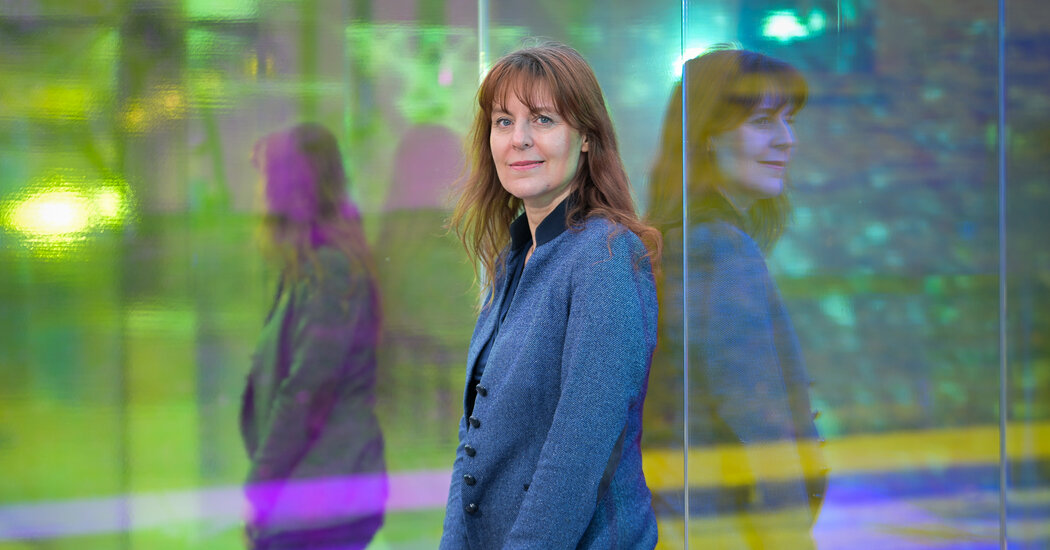Have dinosaurs evolved on other worlds? Could we spot a planet of glowing organisms? What nearby star systems are positioned to observe Earth passing in front of the sun?
These are just a few of the questions that Lisa Kaltenegger has joyfully tackled. As the founding director of the Carl Sagan Institute at Cornell University, she has pioneered interdisciplinary work on the origins of life on Earth and the hunt for signs of life, or biosignatures, elsewhere in the universe.
Dr. Kaltenegger’s new book, “Alien Earths: The New Science of Planet Hunting in the Cosmos,” to be published on April 16, chronicles her insights and adventures spanning an idyllic childhood in Austria to her Cornell office, which previously belonged to the astronomer Carl Sagan. She spoke with The New York Times about the intense public interest in aliens, the wisdom of trying to contact intelligent civilizations, and the weirdest creatures she’s grown in her lab. This conversation has been condensed and edited for clarity.
You look for real aliens in the observable universe. How much is the diversity of opinion and emotion from people around the search for extraterrestrial life top-of-mind in your research? Or are U.F.O.s and sci-fi E.T.s something you have to tune out?
For me, it’s inspirational that so many people are excited. The other part of that coin is that we are so close, because we have the James Webb Space Telescope now being able to look at these small planets that could potentially be like Earth. We don’t have to go with dubious or hard-to-interpret evidence anymore.
I wrote this book because I think a lot of people might not be so aware of where we are right now, and that they are living in this momentous time in history. We can all be a part of it.
How should people prepare for a potential detection of signs of something living in a distant planet’s atmosphere that’s not like you see in the movies, that’s maybe less satisfying?
If we were to find signs of life — any signs that we can’t explain with anything else but life — then that just means we live in a universe teeming with life, because we’re just at the verge of being able to find it. And it’s so hard, even with the best telescopes, so if we find anything, that means there’s so much more to find out there. I’ll celebrate, whatever it is.
The title “Alien Earths” refers to alien worlds, but also the past and future versions of Earth that are alien to us. What is a moment in Earth’s history that you would want to go to?
The moment and place when life started. Because it is such a mystery. You don’t need the whole planet to have conditions to get life started. It could be a niche somewhere. It could be an asteroid that hit just with the right speed and energy and mixed the chemicals on Earth up the right way. It could have been on an ice shell, or in a shallow pond.
There is an overlap between the pioneers of the search for alien civilization and the development of nuclear weapons. Do you think that kind of complicated heritage has shaped expectations about the longevity of intelligent civilizations?
Absolutely. I think in our search for life is buried the hope that if we find life everywhere, on planets older than us, that we will make it. By definition, to be able to travel the stars fast or with propulsion that can get you very far, that same technology can destroy the world you live on and everyone on it.
The question that always comes, and I think it’s a normal question, is: Will you have the wisdom to use this power for good or evil? That’s usually the story. Will you have the wisdom to survive this capability, and this technology?
There is a heated debate over whether we should be actively trying to contact alien life, or if we should just be passively looking for signs of it. Where do you come down on that question?
I was at a Vatican Observatory conference and I was actually the speaker after Stephen Hawking. Oh my god, right? Amazing. But it’s really interesting because he was one of the people who cautioned very much against this.
We are two billion years too late to worry about it. Anybody who would have looked at us for two billion years would know that there’s life on this planet. Basically, the cat’s out of the bag.
But I think it is a very valid concern in terms of social science or sociology, because we don’t want to do anything to scare people. It is worth asking the question to ourselves, too: Are we at the point, all of us, where we’d actually like to communicate with other civilizations? And what would we want to ask?
What inspired you to create the Carl Sagan Institute at Cornell?
I’m an astronomer by training, and I worked on the design of a mission to find signs of life in the universe. We were only looking at carbon copies of modern Earth. But we know that Earth has changed, so if we only look at this tiny part of the history of Earth, compared to its 4.6 billion years, we are going to miss young and future Earths.
To actually answer the question of how our planet works, you need a network of many different departments and many different ways of life. The more diverse background you can get, the more ideas you can get and the more complicated problems you can solve.
You have a lab where you’re growing microbes to inform the search for life. What’s the weirdest thing you’ve grown?
A pink fungus. You have to be very careful about fungi because they spread like crazy. This is why I’m working with microbiologists. One of my team’s microbiologists is like, “I’m not touching this and contaminating all of Cornell with pink fungus.” Imagine that.
So you had to take special precautions to make sure that this alien didn’t invade.
I just imagine a world overgrown with pink fungi.
You have published a study that simulated conditions analogous to the age of dinosaurs on other worlds. How can we specifically search for alien dinosaurs? Because I want to find alien dinosaurs.
During the age of the dinosaurs, there was more oxygen and also more methane, and that allowed for these huge creatures. At least that’s the idea, right? More oxygen can actually make creatures bigger, thus huge dinosaurs.
The fun part when I talked about this with my teammate, geologist Rebecca Payne, is that actually it could be much easier to find a dinosaur planet, to find “Jurassic World.”
Now the question is, of course: Does it have to be dinosaurs? They could be really funky different kinds of organisms that don’t look like dinosaurs.
The realities of probability tell me that dinosaurs can probably exist only once and yet my heart will not believe it.
We have 200 billion stars in our galaxy alone, and there are billions of galaxies. We have billions and billions of possibilities.
Let’s say that we are optimists and we say where life could start, it does start. That’s a hypothesis: We have no idea if that’s true. But maybe dinosaurs twice is actually an option.

